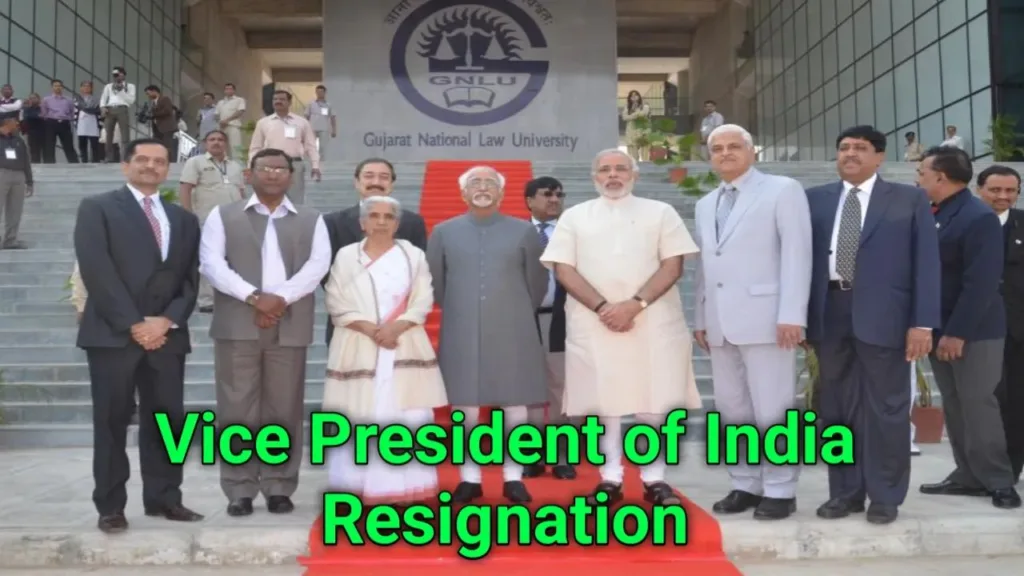
Introduction: A Sudden Political Shift
In a surprising turn of events, Jagdeep Dhankhar, the 14th Vice President of India, resigned from his post on July 21, 2025, citing health reasons. The resignation, which came on the first day of the Monsoon Session of Parliament, has stirred the political landscape of India. This sudden exit has prompted urgent questions: Who will chair the Rajya Sabha? Who will be the next Vice President of India? What does this mean for the political and parliamentary structure?
This article explores the current crisis, the historical evolution of the Vice Presidency, and what lies ahead for this critical constitutional office.
The Role of the Vice President of India
The Vice President of India holds the second-highest constitutional office in the country, directly after the President. The Vice President plays a dual role:
- Vice President of the Republic of India
- Ex-officio Chairperson of the Rajya Sabha (Upper House of Parliament)
The Vice President presides over proceedings in the Rajya Sabha and ensures the legislative process flows smoothly. In the absence of the President (due to death, resignation, or incapacity), the Vice President can act as the President until a new one is elected.
Who Was Jagdeep Dhankhar?
Jagdeep Dhankhar, a seasoned politician and lawyer, assumed the Vice Presidency on August 11, 2022, succeeding M. Venkaiah Naidu. Prior to this role, Dhankhar served as the Governor of West Bengal and was a key figure in the BJP’s political framework. Known for his outspoken nature, he often engaged in sharp exchanges during Rajya Sabha proceedings.
However, on July 21, 2025, he unexpectedly submitted his resignation to President Droupadi Murmu. While Dhankhar cited “health issues” as the reason, many political analysts believe the resignation may reflect deeper political shifts or internal disagreements.
What Happens After the Resignation?
According to the Indian Constitution, the Deputy Chairperson of the Rajya Sabha, currently Harivansh Narayan Singh, will preside over the Rajya Sabha until a new Vice President is elected.
The Constitution mandates that a new Vice President must be elected within 60 days of the position becoming vacant. That sets the deadline for the election to September 19, 2025.
Eligibility for Vice President of India
- Must be a citizen of India
- Must be at least 35 years of age
- Must be qualified to be a member of the Rajya Sabha
- Must not hold any office of profit under the Government of India or a State Government
Historical Background: Evolution of the Vice Presidency
The office of the Vice President of India was established under Article 63 of the Indian Constitution. Since independence, India has had 14 Vice Presidents. Some of the most notable include:
- Sarvepalli Radhakrishnan (1952–1962): Went on to become the President of India
- Shankar Dayal Sharma and Krishna Kant: Played pivotal roles in the functioning of Parliament
- M. Venkaiah Naidu (2017–2022): Known for his disciplined administration of the Upper House
The Vice Presidency has evolved from a largely ceremonial role to one that is actively engaged in the legislative process, especially with the increasing complexity of coalition politics.
The Political Significance of the Vice President
While the role may appear administrative, the Vice President wields significant influence as the Chairperson of the Rajya Sabha. This position requires balancing intense political debates, controlling disruptions, and ensuring that critical legislation is debated and passed efficiently.
With frequent parliamentary deadlocks and walkouts, the Vice President has to demonstrate neutrality, patience, and deep constitutional understanding.
Jagdeep Dhankhar’s tenure witnessed several contentious sessions, particularly during debates on national security, economic reforms, and social justice. His strict enforcement of parliamentary procedure won him both praise and criticism.
Current Situation in Parliament
Following Dhankhar’s resignation, Harivansh Narayan Singh, the Deputy Chairperson, has stepped into the leadership role in the Rajya Sabha. His tenure as interim Chair will likely involve maintaining parliamentary decorum during the remainder of the Monsoon Session.
Meanwhile, political parties are gearing up for the election of the next Vice President. Speculation is rife over possible nominees. Some names under consideration are:
- Harivansh Narayan Singh (JD-U), a likely NDA candidate
- A senior BJP leader or state governor
- A consensus candidate between NDA and opposition for stability
Future Outlook: What to Expect Next?
As per constitutional requirements, the Election Commission will notify the schedule for the Vice Presidential election soon. The electoral college for the Vice President consists of members of both Lok Sabha and Rajya Sabha, including nominated members.
The next Vice President will inherit an increasingly polarized Parliament. The role will demand statesmanship, resilience, and a strong grasp of constitutional values.
Looking ahead, there is also public debate over whether the Vice President’s role should be given more powers or if its dual functionality continues to serve India’s bicameral legislature efficiently.
FAQs: Vice President of India
Q1: Why did Jagdeep Dhankhar resign as Vice President?
A: He officially cited health reasons. However, the timing and suddenness have led to speculation of political or internal parliamentary issues.
Q2: Who is the acting Vice President now?
A: The office of the Vice President is currently vacant. Harivansh Narayan Singh, the Deputy Chairperson, is presiding over the Rajya Sabha.
Q3: When will the new Vice President be elected?
A: As per constitutional mandate, a new Vice President must be elected within 60 days — by September 19, 2025.
Q4: What are the qualifications to become Vice President?
A: A candidate must be at least 35 years old, a citizen of India, eligible for Rajya Sabha membership, and must not hold any office of profit.
Q5: Can the Vice President act as President of India?
A: Yes, in the event the President resigns, dies, or is incapacitated, the Vice President can serve as acting President until a new election is held.
Read More :-TCS Q1 FY26 Results: Net Profit Rises 6%, AI Adoption Won’t Cut Jobs, Says Management
